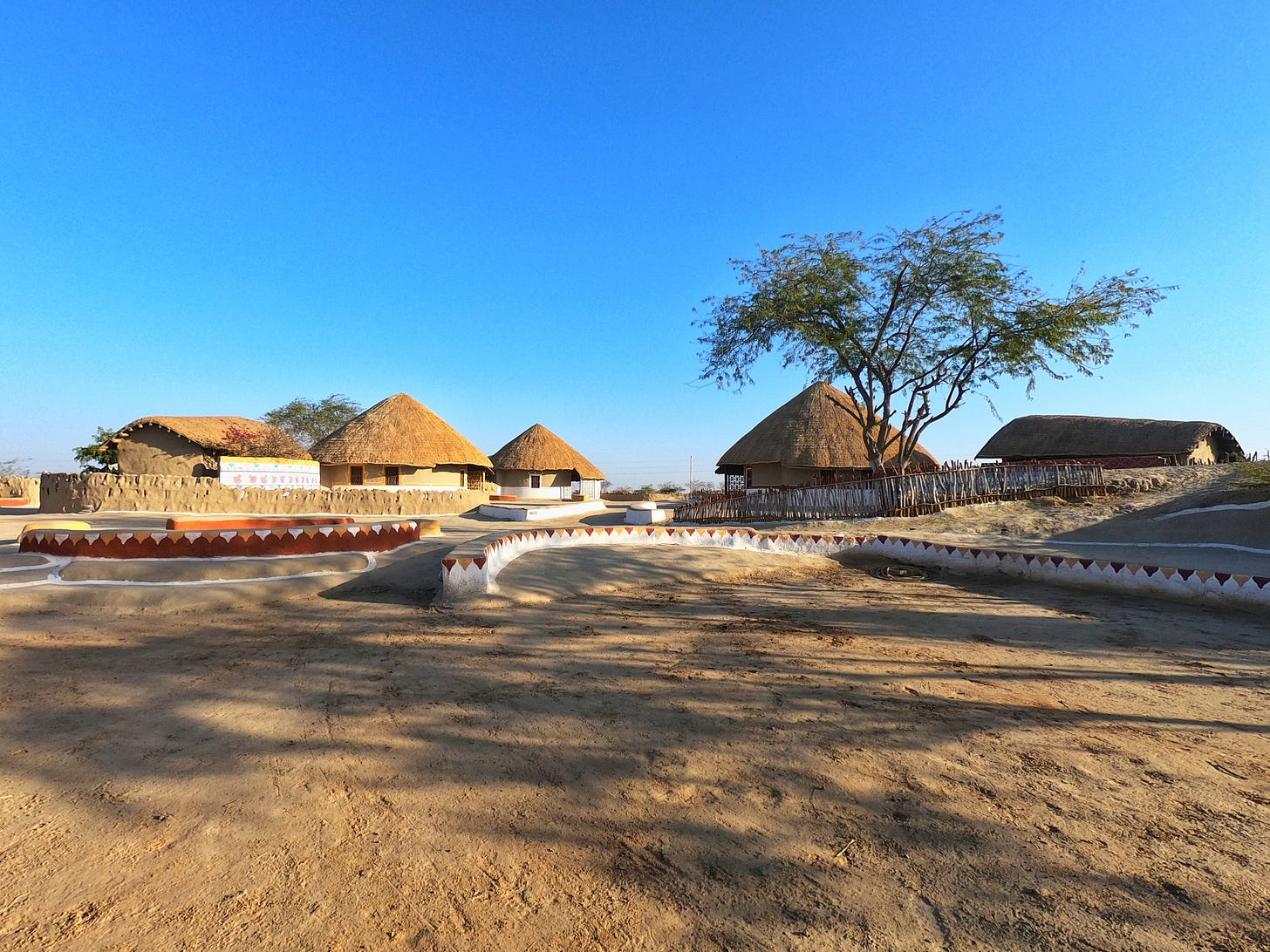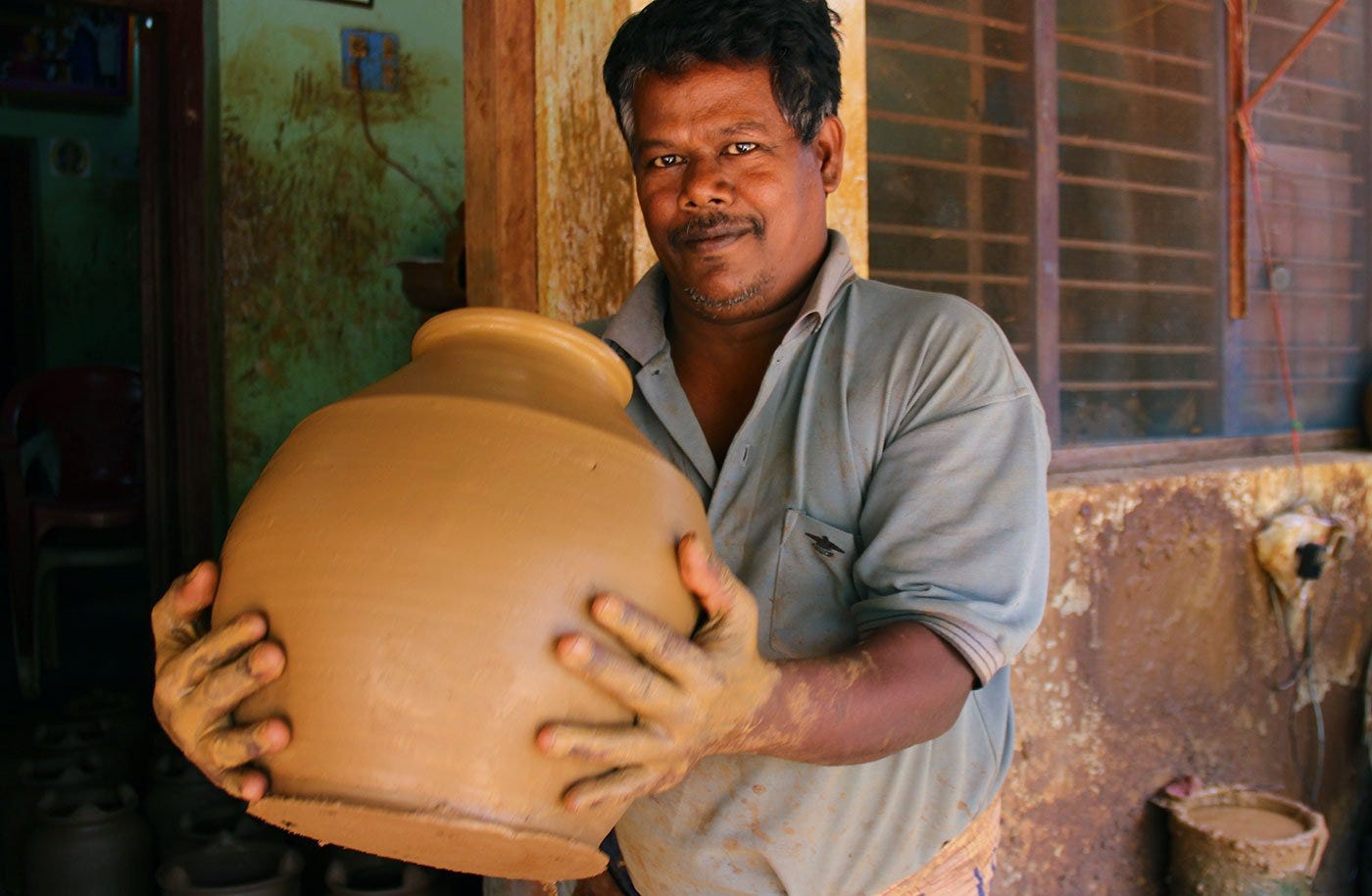It had been a month since my experience in the Dholera Swaminārayan temple that I wrote about in the previous post. From then on, I had cycled over a thousand kilometres across the countryside of Gujarat. It had already been a week since I entered the desert region of Kutch and frankly, I was not in a mood to leave the place to head to Rajasthan.
That was because I had one unfulfilled wish in Kutch. I wanted to listen to some local music as I had heard a lot about the folk music of the region. I especially wanted to listen to someone playing the Alghoza/Jodiya Pawa - a double-flute - where two flutes are played simultaneously. It was then that Rutvid Dholakia - my host and good friend from Bhuj - put me in touch with people who run a place called Shaam-ee-Sarhad in a tiny hamlet of Hodka, 60kms north of Bhuj. I was told that every evening, local musicians from Hodka and neighbouring villages come to perform at the property, and that would be my best bet to listen to local music. So off I went, braving horrendous headwinds and crossing the tropic of cancer for the third time on the tour, to reach the picturesque village of Hodka.


I very well knew that I could not afford to stay at the property, that I would have to pitch my tent in the village outskirts and cook my own meals. I planned to request the people who run the property to just allow me to listen to the music and interact with the musicians. However, as I parked my bike outside the gate and went in to speak, the hosts were so fascinated by my cycle tour that they not only gave me a place to sleep, but also treated me to a wonderful Kutchi meal. ‘Humaare gaon mein aapko bahar sone nahi denge’ (No sleeping outside when you are in our village) they said. I have a lot to say about my experience in Kutch but that is for another time. This post is about a song that I heard in Hodka that fascinated me a lot. And how that song took me to Mānamadurai in Tamil Nadu, to make connections that I did not know existed.

Kabir’s Bartan Maati Ro
The artists who came to perform were simple and unassuming. But there was something so natural and so rustic about their music, that it touched a raw nerve. They even gave an explaination about each song, the background of the poet and the message the song is trying to convey to the listeners. The music, the message and the mahāul, everything was perfect!
Of the many songs they presented, I was particularly amused by this one composition by Kabir Das - a 14th century poet who originally belonged to Awadh region in Uttar Pradesh but whose songs had become popular across north-western India. The song was called ‘Hiye Kāya Mein’ (listen here) and in the opening lines of the song, Kabir says, ‘Hiye Kāya Mein Bartan Maati Ro’ (This body, is a pot made of clay!) If you have read the previous post, you would know that in Dholera, I was told how the flute was a metaphor for a human body. And here is Kabir, using the metaphor of an earthen pot to refer to the human body. I was both confused and fascinated. What could be the reason for the comparison? I asked the musicians if they knew why the metaphor was being used. They were unsure but felt that since our body, like the earthen pot, is delicate and perishable, the comparison has been made. It was sensible but I was not satisfied.
That was because I could also find parallels with Kannada literature for this metaphor. Purandara Dasa, also part of what is called the Bhakti movement of the 14th/15th century, has written a song where the human body is associated with an earthen pot. It is a popular composition called ‘Tārakka bindige’ (listen here) which means - ‘bring me an earthen pot’. Here, the ‘bindige’ - the pot - is referring to the human body. Now, what could be the reason? A lot of things in this world are delicate and perishable, why would Kabir from Uttar Pradesh and Purandara Dāsaru from Karnataka feel an earthen pot would be an apt metaphor?
Answer from Mānamadurai
I was obviously fascinated with the question and was waiting for an opportunity to meet a potter, observe what goes into making an earthen pot, and see if I could find any parallels. Considering this was fundamentally a philosophical question, I was also looking out for any literature that could lead me towards an answer. But did not find anything from the literature I was exposed to.
One year after my Gujarat tour, I found myself planning a trip with my parents to the temple towns of Tamil Nadu. It was then that I sensed an opportunity to visit the village of Mānamadurai in the Shivagangā district of Tamil Nadu, home to a family which has been making Ghatams for the last four generations. Ghatam is essentially an earthen pot, made in a specific manner so that it produces a sound that is in tune with a musical note. This special earthen pot is a popular musical instrument used across folk and classical traditions in India. Could a Ghatam maker provide me the answer?
In 2020, I finally got an opportunity to meet Ramesh Kesavan from Mānamadurai, whose family has carried forward the tradition of making Ghatams for four generations. He was extremely welcoming and patiently showed me around his space, even as I was struggling to interact with him in Tamil. As he was explaining to me the complex process of making these seemingly simple earthen pots, there was one exchange that I distinctly remember. It was one of those ‘ahaa!’ moments.

While explaining, Ramesh mentioned how the making of a Ghatam involved the coming together of all the five primary elements of nature - the Pancha bhūtas as we call them in India - earth, water, fire, air and ether/space. The process of making an earthen pot involves collecting soil from the earth and then mixing it with water. Once the mixture is ready, the lump of moist soil is placed on the wheel and is given a particular shape. Then, it is baked in a fire klin or a furnace where it gets baked. The baked pot is then left to dry in the air for a short period before it becomes hard. Of course, since it is a hollow instrument, there is space inside the pot itself. So, the Ghata that is an amalgamation of all the Pancha bhūtas, the five elements of nature, elements that make up our entire universe. Listening to this from a man who’s family have dedicated their entire lives to making these instruments - the passion with which he explained - was incredible. I was so overwhelmed listening to him that did not realise then that this is exactly the reason why Kabir and Purandara Dāsaru use this as a metaphor for the human body.

A reference in the Shārīraka Upanishad
Even as I had found my answer, I did not realise it until a couple of years later. It was only recently that I chanced upon a text called Shārīraka Upanishad that actually helped me connect the dots. The metaphor of human body as an earthen pot makes sense because, in the Vedic tradition, the human body is considered an amalgamation of the five elements, the Pancha Bhūtas - prthivi (earth), āpah (water), tejas (fire), vāyu (air), ākāsha (space/ether). This is explained in the Shārīraka Upanishad - Sharīra means a body - so essentially an Upanishad that explains the human body. The text is part of Krishna Yajurveda and gives the Vedic interpretation of what the sharīra is all about. The opening lines itself gave me what I was looking for. The text goes -
ॐ अथातः पृथिव्यादिमहाभूतानां समवायं शरीरम् ।
यत्कठिनं सा पृथिवी यद्द्रवं तदापो यदुष्णं तत्तेजो
यत्संचरति स वायुर्यत्सुषिअरं तदाकाशम्Om. The body is a compound of prthivi (earth) and other mahabhutas (primordial elements, as āpas or water, agni or fire, vāyu or air, and ākāsha). (In the body), that which is hard is (of the essence of) earth; that which is liquid is (of the essence of) water; that which is hot is (of the essence of) fire; that which moves about is (of the essence of) vāyu; that which is perforated is (of the essence of) ākasha.
(From the book Thirty Minor Upanishads, translated by K Narayansvami Iyer)
The opening lines clearly state that the human body is a composite of the Pancha Bhūtas. It is also interesting to note the order in which the text mentions the five elements and the order in which these elements come together in the making the Ghatam. If you observe, they are one and the same!
So here was the answer, the logical and the philosophical reasoning behind Kabir calling our Kāya (body) as a Bartan Māti Ro (vessel of clay) and Purandara Dāsaru calling it a Bindige (an earthen pot). It is up to an individual whether one believes in such a theory or not, but one cannot but appreciate how each of these metaphors are so meaningfully chosen by poets like Kabir and Purandara Dāsaru. Their metaphors are puzzling at first, but since they are always grounded in traditional Indian philosophy whose tenets transcend geographical and language barriers, travelling through the texts for a bit will reveal the answers. And the search is always exciting!
What about the flute?
If you had read the previous post, you would obviously ask me, wasn’t the flute being used as a metaphor for the human body? Didn’t you give a different reasoning to explain that? Of course, that is a very valid question. And interestingly, the answer is quite simple. The flute analogy holds good here as well.
The Bamboo flute which is used in India is, well, made of Bamboo grass. The grass grows on earth, and like all plants, the growth of bamboo requires water. Once the bamboo is harvested, fire is used to make the holes in the flute. And since it is a hollow wind instrument, air and space are naturally part of the instrument. So, the flute metaphor too passes the Pancha Bhūta test! Fascinating, isn’t it? :)
In the next post I will write about the uniqueness of Bānsuri and Ghatam, the tedious process of making them, and what makes these two instruments different from any other musical instrument anywhere in the world. It will be based on my interactions with Shri Manjunath Hegde, a veteran flute maker from Sirsi, Karnataka and of course, Ramesh, the Ghatam maker from Manamadurai.
Thanks for taking time to read and do reply with any thoughts/feedback you might want to share!


